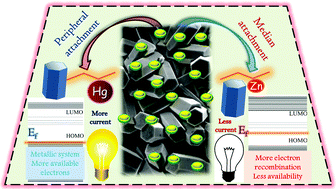Sensitized ZnO nanorod assemblies to detect heavy metal contaminated phytomedicines: spectroscopic and simulation studies†
Abstract
The immense pharmacological relevance of the herbal medicine curcumin including anti-cancer and anti-Alzheimer effects, suggests it to be a superior alternative to synthesised drugs. The diverse functionalities with minimal side effects intensify the use of curcumin not only as a dietary supplement but also as a therapeutic agent. Besides all this effectiveness, some recent literature reported the presence of deleterious heavy metal contaminants from various sources in curcumin leading to potential health hazards. In this regard, we attempt to fabricate ZnO based nanoprobes to detect metal conjugated curcumin. We have synthesized and structurally characterized the ZnO nanorods (NR). Three samples namely curcumin (pure), Zn–curcumin (non-toxic metal attached to curcumin) and Hg–curcumin (toxic heavy metal attached to curcumin) were prepared for consideration. The samples were electrochemically deposited onto ZnO surfaces and the attachment was confirmed by cyclic voltammetry experiments. Moreover, to confirm a molecular level interaction picosecond-resolved PL-quenching of ZnO NR due to Förster Resonance Energy Transfer (FRET) from donor ZnO NR to the acceptor curcumin moieties was employed. The attachment proximity of ZnO NR and curcumin moieties depends on the size of metals. First principles analysis suggests a variance of attachment sites and heavy metal Hg conjugated curcumin binds through a peripheral hydroxy group to NR. We fabricated a facile photovoltaic device consisting of ZnO NR as the working electrode with Pt counter electrode and iodide-triiodide as the electrolyte. The trend in photocurrent under visible light illumination suggests an enhancement in the case of heavy metal ions due to long range interaction and greater accumulation of charge at the active electrode. Our results provide a detailed physical insight into interfacial processes that are crucial for detecting heavy-metal attached phytomedicines and are thus expected to find vast application as sensors for the detection of selective metal contaminants.



 Please wait while we load your content...
Please wait while we load your content...